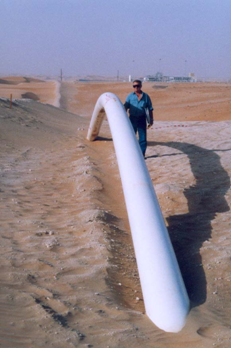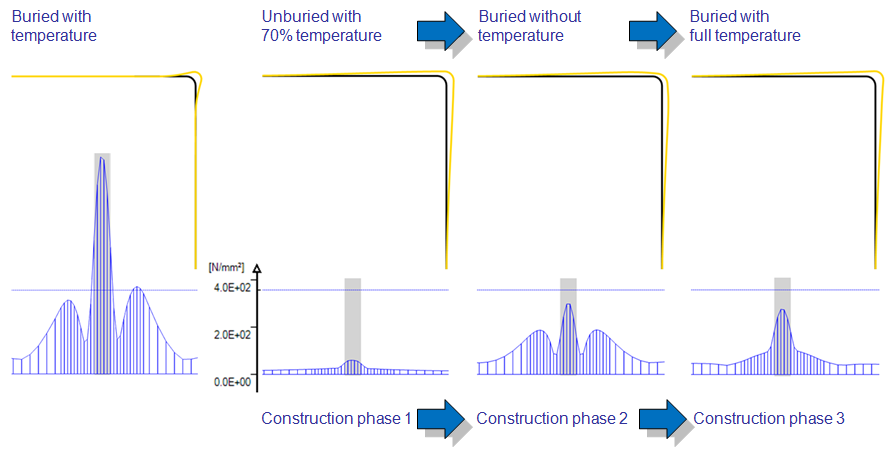
 Ple4Win
Ple4Win

High Pressure High Temperature Pipelines
The combination of high pressure, high temperature loading of a pipeline is most interesting from a point of view of longitudinal behaviour of the pipeline.
First of all where the straight part of the pipeline is restrained by the soil friction, there will be an axial compressive stress combined with a circumferential tensile stress, resulting in a maximum Von Mises stress.
In case of opposite signs of the two principal stresses, the third term in the equation becomes positive (left upper part of the Von Mises ellipse)
But more important is the bend behaviour in such a pipeline. Due to the compressive axial force as a result of the internal pressure and temperature increase the pipeline tends to move towards the bend, counteracted only by the soil friction. The bend cannot follow as the other leg is counteracted by the lateral soil reaction. In case the bend is feeded from both sides, the bend will become squeezed in the soil. This phenomenon is more explicit the smaller the bend radius is.
In case the vertical alignment of the pipeline is not straight, the pipeline may buckle upward if the overburden soil load is not sufficient to withstand the upward load from the pipeline at the overbend. Then the pipeline may rise out of the soil. Such overbending is often seen in desert areas.

Upstream pipeline in desert area
Pipe data
| Pipe material | API 5L X60 steel |
| Pipe length | 1670 m |
| Outer diameter | 12″ |
| Pressure | 380 bar |
| Soil cover | Loose sand, 1.5 m |
Ple4Win results
An upstream gas gathering pipeline laid through desert dunes and buried was analysed after buckles were discovered. Results of the pipeline behaviour analyses are shown (the vertical alignment is strongly pronounced relative to the longitudinal alignment, see also the picture below).

The green line is the ground surface, the black line is the undeformed pipe axis and the yellow line the deformed pipe axis. The latter covers the black line except at the buckles.
Not all buckles extend above the surface. The one at the picture is shown below (right buckle in alignment). The maximum stressing is shown as well together with the yield stress of the pipe material. From this graph it may be clear that at three locations the pipe material yields.

In case of offshore pipelines the same phenomenon is named upheaval buckling. Various buckling shapes may result from pipe/soil interaction especially in case of non-buried offshore pipelines, as the soil friction is often very weak.
At free spans the compressive axial force in the pipeline may as well change into a tensile force if the pipeline has the freedom to expand.
Operational temperatures in upstream pipelines often are quite high. Sometimes, especially where pipelines have to be connected, it is advantageous to preheat the (empty) pipeline during construction in the open trench. After preheating the trench is filled and a tensile axial force remains in the pipeline. The operational temperature load will change this into a compressive axial force.

Ple4Win is very well suited to ‘play around’ with a pipeline, its soil surroundings and loading sequences to find an optimal design or to find new ways to construct a pipeline.